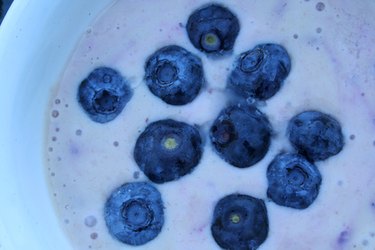
If your doctor has advised you to add more fiber to your diet in the form of psyllium, you're probably wondering how to add it to your favorite foods to experience more overall bowel regularity and possibly lower cholesterol levels. However, while it is easy to add psyllium to liquid and solid foods, you should first learn the risks associated with psyllium consumption to avoid worsening your chronic illness symptoms and prescription drug interactions.
Identification
Video of the Day
Psyllium, an herb indigenous to the Mediterranean and North Africa, contains both insoluble and soluble fiber -- constituents that have been used for many years to treat constipation and to help lower cholesterol, says the American Cancer Society. Insoluble fiber helps your food pass more quickly through your stomach and intestines, says Medline Plus. Soluble fiber attracts water and turns to gel during digestion, a feat that slows down the digestion process and can help lower your cholesterol levels, says Medline Plus. You can find numerous psyllium supplements in most US grocery stores, and you can also add psyllium to your food to elevate the fiber content in your diet and to help you alleviate constipation.
Video of the Day
Liquid Meals
Add psyllium to liquid meals such as protein shakes and fruit smoothies. Add 1 tsp. of psyllium husks to 8 oz. of fluid, suggests NaturalNews.com. Some examples of protein shakes with psyllium are peanut butter and almond milk shakes and protein powder and soy milk shakes. Psyllium can be added to any fruit smoothie, such as mixed berry smoothies, banana smoothies or mango smoothies. When you add psyllium to to any liquid, you have to drink the mixture quickly or the psyllium will swell to a gelatinous consistency that is hard to swallow.
Solid Foods
Sprinkle one to two teaspoons of psyllium on foods such as soup, yogurt or cereal, suggests Medline Plus. You can also make a psyllium replacer to use in the place of eggs in baked goods, says Food.com, by mixing 2 tbsp. of water with 1 tsp. of psyllium. Other ways to enjoy psyllium in solid foods is to add it to recipes such as oat kheer, carrot kheer or peanut butter cookies.
Additional Benefits
Psyllium intake can also help to lower your cholesterol. In a 2000 study conducted by head researcher J.W. Anderson of the University of Kentucky and the Veterans Affair Medical Center in Lexington, Kentucky, women and men with hypercholesterolemia, or high cholesterol, followed the American Heart Association Step 1 Diet for a period of eight weeks. At the end of the eight-week period, some subjects were randomly given 5.1g of psyllium twice daily to take in addition to the diet, while others were given a cellulose placebo twice daily for the duration of the 26-week study. At the end of the study, the researchers found that the participants who consumed the psyllium and followed the diet experienced serum total and LDL-cholesterol levels that were up to 6.7 percent lower than the placebo group.
Warning
Although psyllium can greatly enhance your digestive health, if you do not use it correctly it can also harm you. Psyllium can negatively interact with prescription medications such as Elavil, an anti-depressant, Tegretol, an anti-seizure medication, and Digoxin, a heart medication, says the University of Maryland Medical Center. The UMMC also states that if you have irritable bowel syndrome, too much psyllium can make your symptoms worse, so you should consult with your doctor about adding psyllium to your treatment plan before you begin to use it.
- American Cancer Society: Psyllium
- NaturalNews.com: Satisfy Your Appetite with Psyllium
- PubMed.gov: Long-term cholesterol lowering effects of psyllium as an adjunct to diet therapy in the treatment of hypercholesterolemia
- University of Maryland Medical Center: Possible Interactions with Psyllium
- University of Maryland Medical Center: Psyllium
- Medline Plus: Constipation-Self Care
- PubMed Health: Psyllium
- Food.com: Psyllium Vegan Egg Replacer
- Fat Free Kitchen: Psyllium Husk Benefits & Psyllium Cholesterol reducing recipes
- Milk.com: Wacky Peanut Butter Cookies